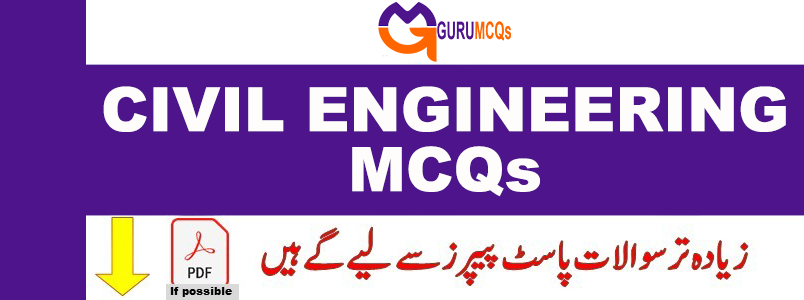
GURU MCQs provides Civil Engineering MCQs for Job Test and Interview Preparation, suitable for fresh graduates, students, and competitive exams. Most repeated civil engineering MCQs section is frequently encountered in CSS, PMS, Inspector, ASI, Sub-Inspector, Constable, FPSC, PPSC, ETEA, FIA, Police, Army, Navy, Airforce, IB, MOFA, ASF, LHC, Educators, and various other competitive exams, as well as government and private job assessments. The most common updated MCQs include Basic Civil Engineering, Building Materials, Surveying, Soil Mechanics and Foundation Engineering, Applied Mechanics, Hydraulics, Waste Water Engineering, RCC Structures Design, Irrigation, Railways, Construction Management, Theory of Structures, Estimating and Costing, Docks and Harbours, Elements of Remote Sensing, Building Construction, Concrete Technology, Advanced Surveying, Strength of Materials, Water Resources Engineering, Water Supply Engineering, Steel Structure Design, Highway Engineering, Airport Engineering, Structural Design Specifications, Tunnelling, and much more.
11. For highway geometric design purposes the speed used is________________?
A. 15th percentile
B. 50 “”percentile
C. 85th percentile
D. 98 “”percentile
12. The maximum width of a vehicle as recommended by IRC is________________?
A. 1.85m
B. 2.44 m
C. 3.81 m
D. 4.72 m
13. Select the correct statement__________________?
A. Traffic volume should always be more than traffic capacity
B. Traffic capacity should always be more than traffic volume
C. Spot speed is the average speed of a vehicle at a specified section
D. 85th percentile speed is more than 98th percentile speed
14. Which of the following methods is preferred for collecting origin and destination data for a small area like a mass business center or a large intersection ?
A. road side interview method
B. license plate method
C. return postcard method
D. home interview method
15. Length of a vehicle affects________________?
A. width of traffic lanes
B. extra width of pavement and minimum turning radius
C. width of shoulders and parking facilities
D. clearance to be provided under structures such as overbridges, under-bridges etc
16. Desire lines are plotted in_________________?
A. traffic volume studies
B. speed studies
C. accident studies
D. origin and destination studies
17. The diagram which shows the approximate path of vehicles and pedestrians involved in accidents is known as___________________?
A. spot maps
B. pie charts
C. condition diagram
D. collision diagram
18. Which of the following is known as design capacity ?
A. basic capacity
B. theoretical capacity
C. possible capacity
D. practical capacity
19. Equivalent factor of passenger car unit (PCU) for a passenger car as per IRC is_____________?
A. 1.0
B. 2.0
C. 0.5
D. 10
20. With increase in speed of the traffic stream, the minimum spacing of vehicles________________?
A. increases
B. decreases
C. first decreases and then increases after reaching a minimum value at optimum speed
D. first increases and then decreases after reaching a maximum value at optimum speed

Pingback: Software Engineering MCQs for Preparation - GURU MCQS